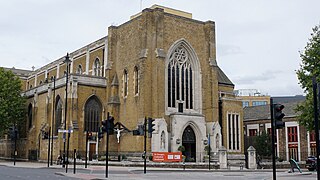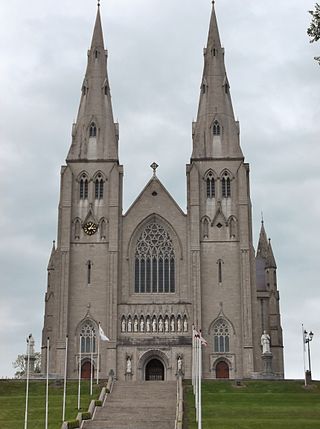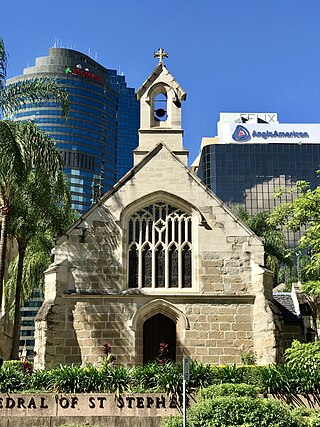
The Metropolitan Cathedral Church of St George, usually known as St George's Cathedral, Southwark, is the cathedral of the Roman Catholic Archdiocese of Southwark, south London, and is the seat of the Archbishop of Southwark.

St. Raphael's Cathedral is a Catholic cathedral and a parish church in the Archdiocese of Dubuque located in Dubuque, Iowa. The parish is the oldest congregation of any Christian denomination in the state of Iowa. The cathedral church, rectory, former convent, and former parochial school building are contributing properties in the Cathedral Historic District on the National Register of Historic Places.

The Cathedral Church and Minor Basilica of Saint Patrick is the cathedral church of the Roman Catholic Archdiocese of Melbourne in Victoria, Australia, and seat of its archbishop, currently Peter Comensoli.

St. Michael's Cathedral Basilica is the cathedral church of the Roman Catholic Archdiocese of Toronto, Canada, and one of the oldest churches in Toronto. It is located at 65 Bond Street in Toronto's Garden District. St. Michael's was designed by William Thomas, designer of eight other churches in the city, and was primarily financed by Irish immigrants who resided in the area. The cathedral has a capacity of 1600. John Cochrane and Brothers undertook the work on the stone and stucco ornamentation of the interior.

The Cathedral Church and Minor Basilica of the Immaculate Mother of God, Help of Christians, Patroness of Australia is the cathedral church of the Roman Catholic Archdiocese of Sydney and the seat of the Archbishop of Sydney, currently Anthony Fisher OP. It is dedicated to the "Immaculate Mother of God, Help of Christians", Patroness of Australia and holds the title and dignity of a minor basilica, bestowed upon it by Pope Pius XI on 4 August 1932.

The Basilica of Saint Mary is a Roman Catholic minor basilica located on its own city block along Hennepin Avenue between 16th and 17th Streets in downtown Minneapolis, Minnesota. It was the first basilica established in the United States. The Basilica of Saint Mary is the co-cathedral of the Roman Catholic Archdiocese of Saint Paul and Minneapolis.

St. Patrick's Cathedral in Armagh, Northern Ireland is the seat of the Catholic Archbishop of Armagh, Primate of All Ireland. It was built in various phases between 1840 and 1904 to serve as the Roman Catholic cathedral of the Archdiocese of Armagh, the original medieval Cathedral of St. Patrick having been retained by the state church, the Church of Ireland at the time of the split of the Irish Church during the Reformation.

The Metropolitan Cathedral Church and Basilica of Saint Chad is a Catholic cathedral in Birmingham, England. It is the mother church of the Archdiocese of Birmingham and is dedicated to Saint Chad of Mercia.

Rouen Cathedral is a Catholic church in Rouen, Normandy, France. It is the see of the Archbishop of Rouen, Primate of Normandy. It is famous for its three towers, each in a different style. The cathedral, built and rebuilt over a period of more than eight hundred years, has features from Early Gothic to late Flamboyant and Renaissance architecture. It also has a place in art history as the subject of a series of impressionist paintings by Claude Monet, and in architecture history as from 1876 to 1880, it was the tallest building in the world.

The Basilica of the Sacred Heart in Notre Dame, Indiana, is a Catholic church on the campus of the University of Notre Dame, also serving as the mother church of the Congregation of Holy Cross (C.S.C.) in the United States. The neo-gothic church has 44 large stained glass windows and murals completed over a 17-year period by the Vatican painter Luigi Gregori. The basilica bell tower is 230 feet (70 m) high, making it the tallest university chapel in America. It is a contributing building in Notre Dame's historic district listed on the National Register of Historic Places. The basilica is a major tourist attraction in Northern Indiana, and is visited annually by more than 100,000 tourists.

St John's Cathedral is the cathedral of the Anglican Diocese of Brisbane and the metropolitan cathedral of the ecclesiastical province of Queensland, Australia. It is dedicated to St John the Evangelist. The cathedral is situated in Ann Street in the Brisbane central business district, and is the successor to an earlier pro-cathedral, which occupied part of the contemporary Queens Gardens on William Street, from 1854 to 1904. The cathedral is the second-oldest Anglican church in Brisbane, predated only by the extant All Saints church on Wickham Terrace (1862). The cathedral is listed on the Queensland Heritage Register.

The Cathedral Church of St. John the Evangelist, usually known as Salford Cathedral, is a Catholic cathedral on Chapel Street in Salford, Greater Manchester, England. It is the seat of the Bishop of Salford and mother church of the Diocese of Salford, and is a Grade II* listed building.

The Cathedral Church of St Mary and St Thomas is a Roman Catholic cathedral in Northampton, England. It is the seat of the Bishop of Northampton and mother church of the Diocese of Northampton which covers the counties of Northamptonshire, Bedfordshire, Buckinghamshire and part of Berkshire north of the River Thames. The cathedral is situated in the north of the town, along the Barrack Road.

The medieval cathedrals of England, which date from between approximately 1040 and 1540, are a group of twenty-six buildings that constitute a major aspect of the country's artistic heritage and are among the most significant material symbols of Christianity. Though diverse in style, they are united by a common function. As cathedrals, each of these buildings serves as central church for an administrative region and houses the throne of a bishop. Each cathedral also serves as a regional centre and a focus of regional pride and affection.

St Mary of the Angels is a Catholic church on the corner of Boulcott Street and O'Reily Avenue in Wellington, New Zealand. It is the parish church for Wellington Central and one of the major churches of the city. The Marist Fathers have provided clergy for St Mary of the Angels since 1874 in succession to its founding and long-serving parish priest, the Capuchin Franciscan, Father Jeremiah O'Reily. The church was used by Archbishop O'Shea as his pro-cathedral (1936–1954). It was the site of the funeral of Suzanne Aubert in 1926 and is well known for its church music tradition.

The Church of Our Lady of the Assumption and the English Martyrs, also known as the Church of Our Lady and the English Martyrs (OLEM), is an English Roman Catholic parish church located at the junction of Hills Road and Lensfield Road in southeast Cambridge. It is a large Gothic Revival church built between 1885 and 1890, and is a Grade I listed building.

The Church of Saint Ignatius Loyola is a heritage-listed Roman Catholic church at 46 Grove Street, Toowong, City of Brisbane, Queensland, Australia. It was designed by architect Jack Hennessy, junior, and built from 1929 to 1936 by Concrete Construction (QLD) Limited. It was added to the Queensland Heritage Register on 12 July 2005.

St Mary's Church is a heritage-listed Roman Catholic church at 20 Merivale Street, South Brisbane, Queensland, Australia. It was designed by Simkin and Ibler and built from 1892 to 1929. It was added to the Queensland Heritage Register on 3 December 2004.

St Stephen's Chapel, also known as the Pugin Chapel, and formerly known as Old St Stephen's Church, is a heritage-listed Roman Catholic former church, now chapel, located at 249 Elizabeth Street, Brisbane City, City of Brisbane, Queensland, Australia. It was designed by Augustus Pugin and built from 1848 to 1850 by Alexander Goold and Andrew Petrie.

St Monica's Cathedral is the cathedral of the Catholic Church in the Diocese of Cairns. It is located at 183 Abbott Street, Cairns City, Cairns, Queensland, Australia. The cathedral was designed by Ian Ferrier and built from 1967 to 1968. It was added to the Queensland Heritage Register on 31 August 1998.






















